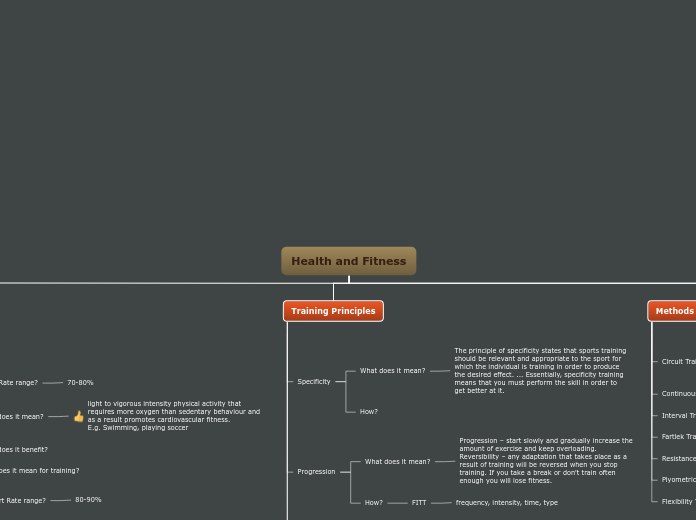a Emma Lennard 4 éve
205
Tree organigram
Physical activity encompasses various aspects of fitness, including motor fitness which is skill-related and involves components like power, agility, coordination, reaction time, speed, and balance.

a Emma Lennard 4 éve
205

Még több ilyen
Physical fitness refers to the capacity of an athlete to meet the varied physical demands of their sport without reducing the athlete to a fatigued state.
Motor Fitness refers to the ability of an athlete to perform successfully in their sport.
Fitness is the ability to meet the demands of a physical task. Can be divided into two sub-categories: physical fitness and motor fitness.
Fitness will be lost if the training load is reduced or if a performer stops training. If this occurs, adaptations from training will be reversed (lost). Endurance is lost in a third of the time it took to achieve. Strength declines more slowly, but lack of exercise leads to atrophy (decreased muscle mass).
Type
Time
Intensity
Frequency
How often
Number of sessions per week
Number of sets
Number of repetitions
Fitness can only be improved by training more than you normally do. Without increased demands, improvements in physical fitness will not occur. For a training program to be effective, it must place increased and specific demands on the body.
FITT
frequency, intensity, time, type
Progression – start slowly and gradually increase the amount of exercise and keep overloading. Reversibility – any adaptation that takes place as a result of training will be reversed when you stop training. If you take a break or don't train often enough you will lose fitness.
The principle of specificity states that sports training should be relevant and appropriate to the sport for which the individual is training in order to produce the desired effect. ... Essentially, specificity training means that you must perform the skill in order to get better at it.
Mental Health (Intellectual Health)
Social Health
Physical Health
Emotional Health
Speed
The ability to perform a movement or cover a distance quickly and at a high intensity.
Reaction Time
The interval time between the presentation of a stimulus and the initiation of the muscular response to that stimulus.
Power
The ability to exert maximum muscular contraction instantly in an explosive burst of movements. The two components of power are strength and speed.
Coordination
The ability to control at least two body parts to perform a specific task that is smooth and well-timed.
The ability to control the centre of gravity in static (stationary) and dynamic (moving) positions.
Agility
Recognised Fitness Test
: Illinois Agility Test
side step in touch
What is it?
The ability to move the whole body quickly and change direction (turn, dodge, weave) whilst maintaining balance and control.
Muscular Endurance
Muscular Strength
The ability to keep using your muscles to exert a force for an extended period of time without fatigue.
Cardiorespiratory Endurance
Body Composition
A number of sports require a mixture of more than one somatotype (Cycling)
Most people are a mixture of more than one somatotype
Recognised Fitness Test?
endomorph
lots of body fat, lots of muscle. More suited to sports like Rugby
ectomorph
Long and lean, with little body fat, and little muscle.
mesomorph
Average build, athletic, solid, and strong
Examples?
used to describe the percentage of fat in the body
designed to stretch muscles to increase range of motion
The range of motion around a joint and resistance of a joint to motion – inclusive of ligaments, tendons and muscles.
aimed at increasing the strength of muscles to allow you to carry out
helps to prevent falls and ibncreases stability
Anaerobic Exercise
Subtopic
intense physical activity that is short in duration and requires a breakdown of energy sources in the absence of sufficient oxygen. E.g. Sprinting (athletics or in game play)
80-90%
Aerobic Exercise
How does it mean for training?
What does it benefit?
What does it mean?
light to vigorous intensity physical activity that requires more oxygen than sedentary behaviour and as a result promotes cardiovascular fitness. E.g. Swimming, playing soccer
Heart Rate range?
70-80%